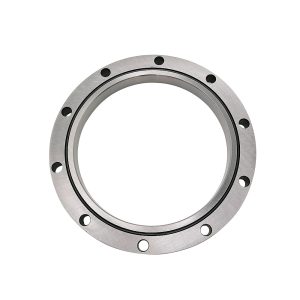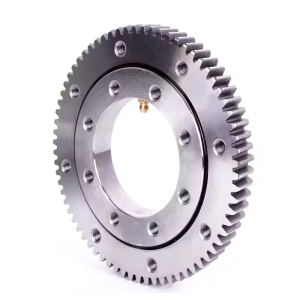Time : Outubro 25, 2024
Crossed roller bearings are crucial in high-precision turntables because of their high load-bearing capacity and rigidity.
These bearings have rollers that cross each other at 90-degree angles. This special design lets them handle all kinds of loads at the same time while working accurately. These bearings are made from strong materials like AISI 52100. They’re compact yet can handle heavy loads without bending much. They’re great for space-constrained applications in medical and robotics fields where precision is key.



The difference between slewing bearings and crossed roller bearings
Structure, application fields, performance characteristics
Slewing bearings and crossed roller bearings have significant differences in structure, application fields and performance characteristics.
Structural differences
Slewing bearing: It is usually composed of a worm, a slewing bearing, a housing, a motor and other components. It looks like a plate, so it is also called a “slewing bearing”. It can withstand large axial load, radial load and overturning moment at the same time, and is suitable for mechanical equipment that withstands huge overturning moment and performs relative rotational motion.
Crossed roller bearing: The inner ring is divided, the outer ring rotates, and the rolling elements are arranged vertically with each other on the V-shaped groove. This structure enables crossed roller bearings to withstand radial and axial loads at the same time, and can be assembled in all directions, making it suitable for high-precision, high-speed application scenarios.
Differences in application areas
Slewing bearings: Widely used in heavy machinery and equipment such as truck cranes, railway cranes, port cranes, excavators, CT machines, tanks, etc., as well as in situations that require high load-bearing capacity and complex motion control.
Crossed roller bearings: Mainly used in high-precision, high-speed equipment such as high-speed machine tools, precision rotary indexing tables, vertical and horizontal boring machines, vertical grinders, rotating cameras, industrial robot joints, CNC turntables, etc. .
Differences in performance characteristics
Slewing Bearing: It has high load-bearing capacity, high efficiency and good sealing performance, and is suitable for fields that require high working life. It has a high level of precision, low radial runout and axial runout, and low operating noise, making it suitable for high-precision and low-noise working environments.
Crossed roller bearing: It has the characteristics of high rotation efficiency, low heat dissipation, and low grease consumption. Due to its compact structure, it can withstand multi-directional loads and is suitable for applications where space is limited but high precision and rigidity are required.
In summary, slewing bearings and crossed roller bearings have their own advantages in structure, application fields and performance characteristics. Choosing the appropriate bearing needs to be determined based on specific application requirements and environmental conditions.
| Feature | Turntable Bearings | Slewing Bearings |
| Focus | High-precision applications (e.g., machine tools) | Heavy-duty applications (e.g., construction machinery) |
| Design Variants | Not specified | Four-point contact ball bearing, eight-point contact ball, cross roller, triple-row cross roller slewing bearing , thrust ball slewing rings, and customized slewing bearings. |
| Composition and Capabilities | Precision rotation, radial and axial load support | Worm gears, housings, motors, withstand axial, radial forces, and overturning moments |
| Inscrição | Light to medium equipment | Heavy machinery |
| Load Capacity | Moderate | High |
| Precision | Moderate | High |
| Flexibility Across Environments | Low to Moderate | High |


